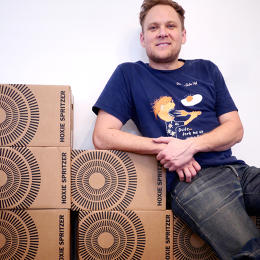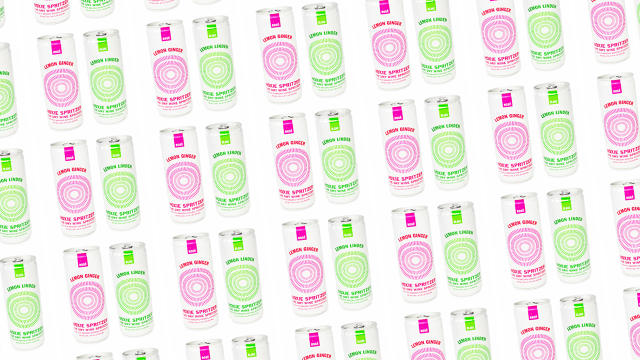How Hoxie Spritzer Is Making Wine Cooler Than Ever
As a New York City chef, Josh Rosenstein devised a cocktail that was perfect for working the line, a combination of cooking wine with leftover fruit scraps and a splash of soda water. It was an ideal drink for kitchen staff: tasty, simple, and hydrating enough to drink throughout the day.
The back-kitchen brew stayed with him as he made his way West, catering farm-to-table private dinners for the Los Angeles elite. While tending to his high-end clientele, he noticed a repetitive drink request: keep it light.

“People were looking for low-alcohol alternatives,” Rosenstein says, “something refreshing that could get a party started.” He soon concocted “elevated wine spritzers” featuring fresh farmer’s market produce, seasonal fruit, some muddled herbs. It wasn’t long before the community started to encourage his side talent.
“At one of the dinners, a friend said, ‘You should put these in bottles,’” he recalls. Rosenstein quickly dismissed the idea. Then, two nights later, during a dinner with friends, he noticed that every single attendee ordered rosé along with a splash of soda water.
The next morning, Rosenstein called up that friend to say he was in. They’re now business partners in Hoxie Spritzers, a dry wine mixed with natural ingredients such as linden blossoms and containing just 5% alcohol. Three years after he began to brew the first spritzers in his garage, Rosenstein’s refreshment can be spotted in celebrity-frequented restaurants, intimidating wine stores, and hip establishments like the Ace Hotel.
Spritzers have become fashionable over the last few years for a few reasons, one being that young people today prefer a lighter alcohol beverage. “Spritzers are happening because they’re lower in alcohol, and that means you can drink more of them, and with fewer hangovers,” says David Tamarkin, the editor of Epicurious.com, pointing to the long-held drinking rule of one glass of water per drink.
Sparkling water, generally, is also having a moment. One need only look to the explosion of LaCroix or the return of the beloved Original New York Seltzer brand. Bubbly water is even being added to coffee now. A Nielsen study showed that sparkling water sales skyrocketed in the U.S., growing more than 15% in four years.
“Everything is going sparkling,” says Tamarkin, noting the mainstream popularity of the SodaStream. “For so many, sparkling is a default drinking choice. It’s become an expectation of consumers that if you have a beverage, one of the options is going to be sparkling and one isn’t.”
Indeed, as Rosenstein recounts, his product is often called “the LaCroix of wine.”
“We’re Not A Wine Cooler”
One of Hoxie’s main objectives was to bring quality wine back to chilled beverages, what most call “wine coolers.” That sugary-sweet beverage, which was popular around the same time Wham! topped the charts, substituted real wine with more affordable malt liquor. “We were up against that,” admits Rosenstein. But, he affirms, “we’re not a wine cooler.”
That was hardly the biggest challenge. Rosenstein made a lot of rookie mistakes at the outset. He long held on to the idea of using lemons from his local farmer’s market. “I had this fantasy that me and all my friends would crush and zest them, but it doesn’t quite work that way,” he explains. “Once you get into the beverage industry, there’s so much regulation at every stage. And all these taxes.”
He learned, for example, that if the carbonation level is too high, the company incurs a “champagne tax.” In order to keep the product in a lower tax bracket, Hoxie has to maintain just the right amount of effervescence. “That was no easy task,” he says. “Through months and months of experimentation, we finally hit the right level.”
Rosenstein ultimately got what we wanted without sacrificing his commitment to taste or style. His spritzers come in sophisticated flavors, like lemon linden blossom and lemon ginger (featuring real rose petals). The ingredients are locally sourced, using citrus oils and other natural extracts.
Every aspect was thoroughly thought out. Take, for example, the company’s search for what Hoxie calls “the unsung American grape.” Rosenstein’s quest for the perfect grape led him through dozens of varieties until he settled on the Catawba, native to the Mid-Atlantic, Northeast, and the Midwest. A fermented Catawba has a lower alcohol content than, say, a petit verdot, but when turned into a spritzer has notes similar to a Riesling.
The Catawba also reflects the Hoxie ethos: It’s a fuss-free grape that doesn’t need much tending to. “They’ll take anything Mother Nature throws at them,” says Rosenstein. Catawba was also the the first grape ever used to make commercially sold sparkling wine in the United States.

DIY’ing It
Rosenstein self-funded and bootstrapped his business, trying his best to talk with as many industry insiders, distributors, wine store owners, and restaurateurs as possible. It wasn’t easy, especially since he was repeatedly told that his vision wouldn’t be feasible without a multimillion-dollar investment.
“I kept hearing that if a large company was trying to pull off what you are doing, they’d spend a minimum of $10 million on R&D, and tens of millions on marketing,” says Rosenstein, who wasn’t deterred. “I saw the marketing done by some of the larger players out there as dated, and not really speaking to the consumer. I felt strongly that if the product is delicious and we stick to a very finite—although competitive—market, the buzz would happen organically.”
The next year saw the entrepreneur turning his apartment into a “laboratory,” spending “thousands of hours of experimenting and testing” until he had a product—and business plan—he felt comfortable sharing with friends and family to raise seed money.
Then, around the release of the first bottle run, the buzz began. Actress Amanda Peet raved about the product in an interview, which led to inquiries from buyers, distributors, and other press outlets. Hoxie quickly accrued five accounts, and three months later, they had total of 21, including the ACE Hotel.
Can It
Rosenstein originally envisioned Hoxie as a bottled drink, not something that came from an aluminum can. But he kept hearing the same thing from hotels and bars: People want to drink this by a pool. Or a beach. Or in the park. He embraced the idea, and it worked.
Within a month of switching from bottles to cans, Lena Dunham posted a picture of Hoxie on her Instagram and even featured a bottle of Hoxie in the Girls season finale.
“Getting away from the glass bottle allowed people to take Hoxie anywhere they wanted,” he says. Not to mention, shipping cans is “so much easier.”
When it came to getting the product on shelves, Hoxie had less of a strategy and more of an overall feeling of where they wanted to be—like-minded companies and stores.
“We targeted places that we would want to shop, drink, eat, and sleep at,” explains Rosenstein. “Places owned or operated by people we want to work with.”
And they were embraced, first in California. In the past year, they’ve doubled sales, tripled the amount of accounts they service (from 20 to 60), and volume is up five times year-on-year. Hoxie is planning to extend its nationwide reach, and to introduce new flavors.
“The Perfect Storm”
Randy Clement, owner of Silverlake Wine, stocks Hoxie because spritzers are what his clientele in the hip Los Angeles community demand. He’s seen a new generation take to the beverage, in part because it feels like summer.
“There are enough younger people in this country drinking wine now,” he says of consumers’ shifting habits. In fact, a study by the Wine Market Council found that 29% of American wine drinkers is comprised of those between 21 and 34 years old, with their interest increasing.
“Rosé was the first thing to attach itself to a season, and I think wine-related drinks are such a part of people’s lives now,” says Clement. “They’re looking for specific things to fulfill specific times of the year.”
Hoxie also appeals to another consumer trend, one generally reserved for cheese and chocolate.
“People want artisanal, they want craft, they want handmade,” says Clement. “They want things where there’s a certain narrative and context.”
Consumer demand for variety and local beverages boasts the fastest revenue growth of all alcohol segments, according to Beverage Industry magazine. That’s mostly due to millennials’ drinking patterns, which treasures individualism and uniqueness, leading them to drinks like craft beers. (A recent study showed that 44% of drinkers between the ages of 21 to 27 have never tried a Budweiser.)
So it’s no surprise that other companies have also jumped on the packaged hard seltzer craze. Just this month, Mark Anthony Brands, responsible for Mike’s Hard Lemonade, announced their new line of White Claw Hard Seltzer, a spiked seltzer that caters to “today’s healthier lifestyles and choices.” There’s also Truly Spiked & Sparkling, made by Boston Beer, the company behind Samuel Adams Beer.
Hoxie, however, has the story that will resonate with the generation it’s targeting, Clement believes. It’s a story of craftsmanship, quality, and enough quirky design to spruce up your Instagram.
“It’s the perfect storm of the right place, right time, with the right person and the right story,” says Clement.
Fast Company , Read Full Story
(38)


